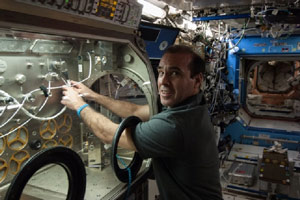- News
20 August 2014
SETi’s UV LEDs used in decontamination system on International Space Station
Conducting science experiments in space, aboard the International Space Station, presents many challenges from working in a microgravity but, due to the Microgravity Science Glovebox (MSG), those aboard the space station have been able to safely conduct their experiments since 2004. Over the past 10 years, the MSG has been put to good use on a wide range of research programs but now, thanks to the activation of a new decontamination system inside the MSG, crew members can now safely perform biological research.
 Picture:
NASA astronaut Rick Mastracchio prepares to use Teledyne Brown’s system to decontaminate hardware used for life science experiments inside the Microgravity Science Glovebox on the ISS. Photo Credit: NASA.
Picture:
NASA astronaut Rick Mastracchio prepares to use Teledyne Brown’s system to decontaminate hardware used for life science experiments inside the Microgravity Science Glovebox on the ISS. Photo Credit: NASA.
Developed and built by Teledyne Brown Engineering Inc (TBE), the decontamination system uses high-power UVCLEAN ultraviolet light-emitting diodes (UV LEDs) from Sensor Electronic Technology Inc (SETi) of Columbia, SC, USA, developed in part through the US Defense Advanced Research Projects Agency (DARPA) Compact Mid-Ultraviolet Technology (CMUVT) program. The UV LEDs have the power to sanitize the surfaces, liquids and air inside the MSG within minutes and, for the safety of the crew, are used before and after experiments are conducted.
The upgraded MSG with TBE’s decontamination system and SETi’s UV LEDs will allow for a much wider range of microgravity experiments and will be available to all biological payloads that operate in the MSG with a concern about contamination.
“Our products passed space flight qualification in the past”, comments SETi’s president & CEO Dr Remis Gaska. “However, this is the first space launch, installation and successful testing of our devices in the orbit,” he adds. “This demonstrates the level of maturity of deep UV LED technology”.
Sensor Electronic Technology UV LEDs
www.nasa.gov/mission_pages/station/research/news/


